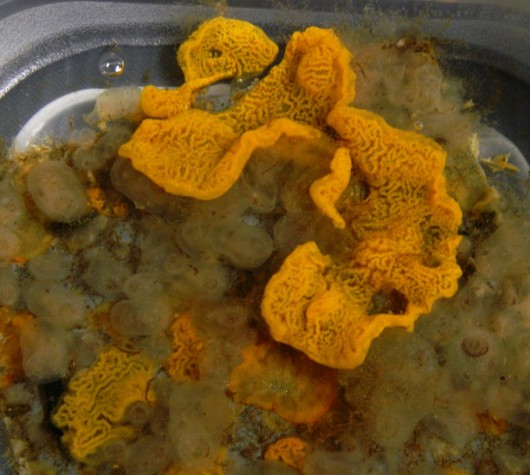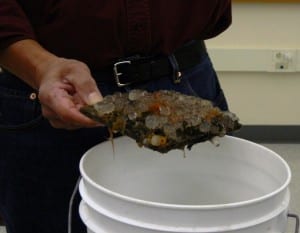It was called BioBlitz, which is an apt name. The biological information was blitz-like. There was a lot of it, in a short period of time. But the basic message got through: Marine invasive species are here, or are on their way. And we need to keep an eye out for them, because they could hurt Alaska’s ocean.
A group of scientists, most of them from the Smithsonian Institution’s Chesapeake Bay campus, ran the blitz, with help from local marine scientist Gary Freitag.
Linda McCann was one of the visiting experts. Her presentation included some discussion
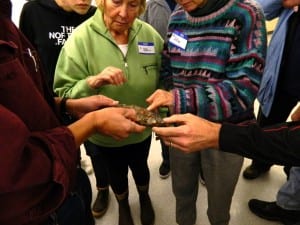
BioBlitz participants examine sea squirts, native and invasive, on a collection plate during the lab portion of the workshop.
of invasive kelp and crabs, but the main focus of this bioblitz was tunicates – sea squirts. There are plenty of tunicates that are supposed to be here, but a few have been moving in that are causing worry among scientists. And, they’re keeping an eye on that movement.
“We have a collecting device, which is really high-tech,” she said. “It’s a plate of PVC, about 14 centimeters square.”
OK, It’s not that high-tech, but those plates provide a great surface for tunicates, and in advance of the workshop, the scientists hung a bunch off the dock at Refuge Cove Marina. After the lab portion, everyone drove out to try their new tunicate-identification skills in the field. Hold on, though. That’s later. We still need to learn a little about these invasive squirts.
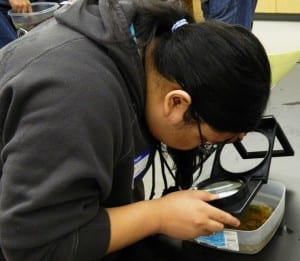
A BioBlitz participant takes a really close look at what’s growing on a collection plate during the lab portion of the workshop.
There’s one in particular that was identified a few years ago in Sitka. Didemnum Vexillum hasn’t arrived in Ketchikan yet, but they’re expecting to find it soon. It’s a green, mossy clump that looks a lot like a sea sponge. But it grows really fast, and can cover up and smother other organisms. McCann described how to tell the two apart.
“This is one of those instances when touch can be really helpful,” McCann said. “If you touch it and it’s springy, and it doesn’t feel slimy and leathery, it’s most likely a sponge.”
A couple of alien squirts that already are in Ketchikan, and were the stars of bioblitz, are Botryllus schlosseri – also known as the golden star tunicate – and Botrylloides violaceus – the sheath tunicate. They also reproduce rapidly, and can take over areas from native species.
But, how do these invasive species get here? Well, basically, it’s our fault.
“Most of these species probably came either on a boat from Asia, or they may have come from the East Coast. A lot of these were introduced to the East Coast first,” McCann said.
Tunicates are filter-feeders, so they attach themselves to something – like a boat — and
then just hang out, waiting for microscopic food to float their way. If they end up in a good environment, their offspring can start a new colony.
After the lectures, there was a lab, where everyone got some guided hands-on experience identifying the two invasive tunicates, which are usually, but not always, bright orange.
And then, on that cold, rainy Saturday afternoon, the scientists-in-training head out to the marina. We break into teams, and each has a team leader.
In addition to checking the PVC plates, we check underwater growth on the side of the wooden dock, one meter to the left and right of each hanging plate. Sounds simple, right? It wasn’t. There was plenty of orange stuff just under the water, attached to the dock, but it was nearly impossible for this amateur to tell whether it was one of the invasive species.
I wasn’t the only one having trouble.
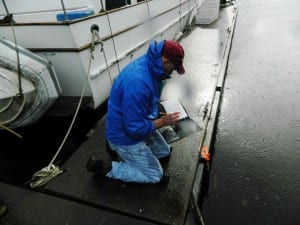
Gregg McNeil makes a note of what he identified during the field work portion of the bioblitz workshop, out at Refuge Cove Marina.
“All kinds of goodies, but hard to tell which is which,” said Gregg McNeil, who was lying on his stomach on the cold, wet, wooden dock, to get the best view possible of what was growing in his sampling area. “We’ve got some sea anemones down here, but I don’t think any of them are (sea squirts).”
McNeil said he’s always been interested in biology, and he was happy to find a useful outlet for that interest.
So far, Alaska is behind the curve on marine invasive species, compared to the rest of North America, but the 49th state is not immune by any means. Scientists want to keep a close eye on the progress of all invasive species heading toward Alaska. It’s a big state, though, which is why they want to recruit and train local residents on simple sampling techniques.

